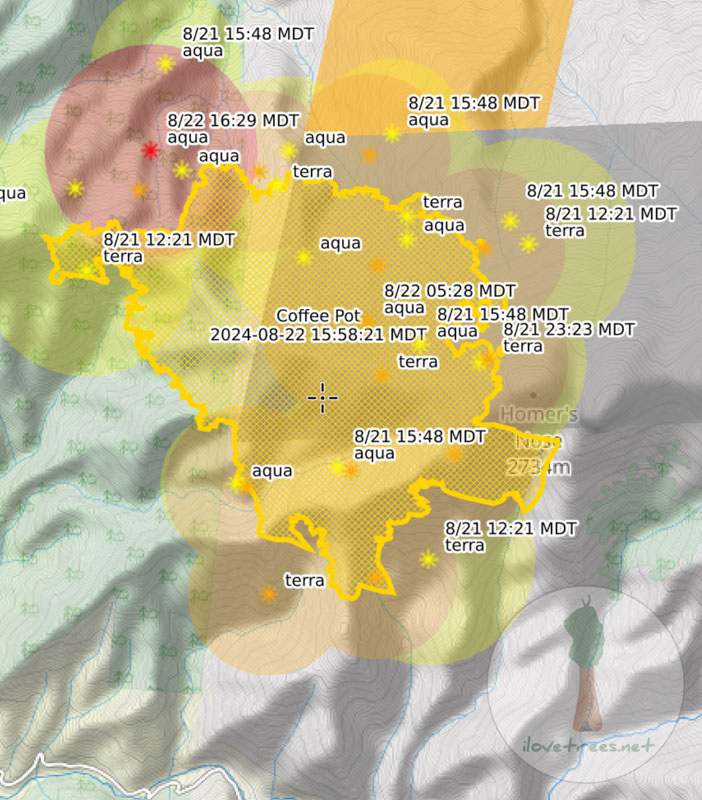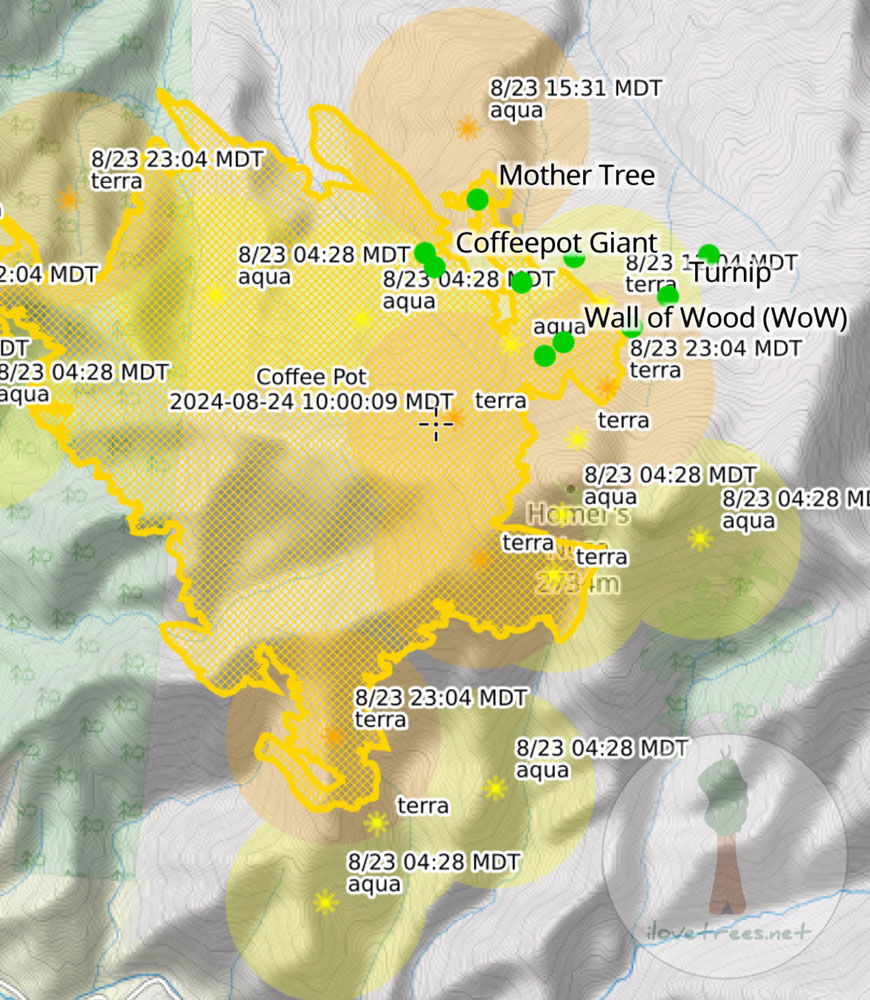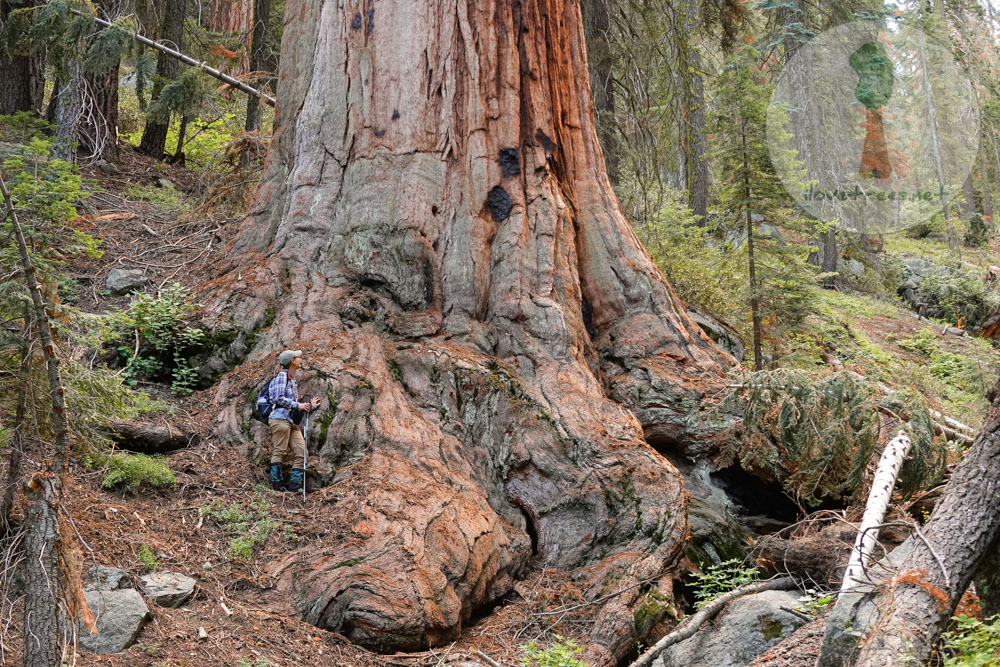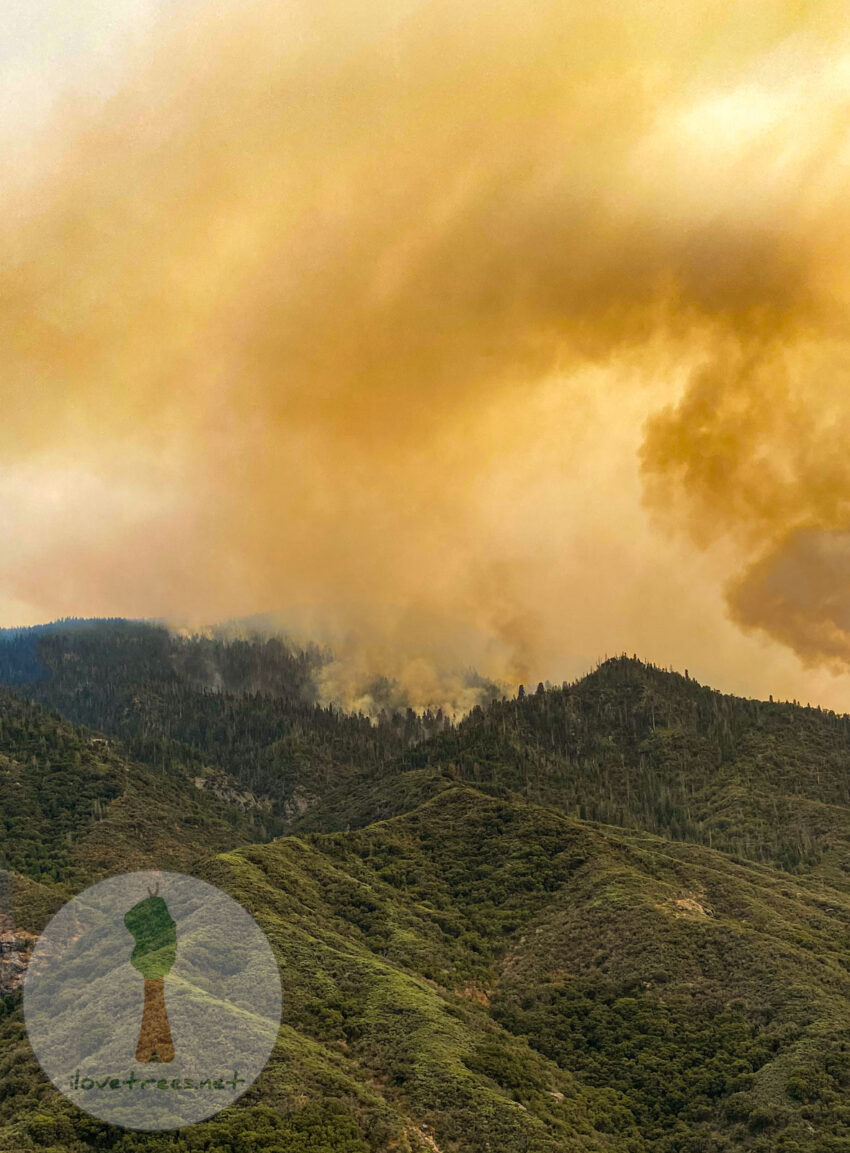by Sue Cag
Featured Image: Eden Creek Grove burning after a helicopter dropped fire bombs into the sequoias, August 27, 2024.
Summary: The Coffee Pot Fire kept fizzling out, but the National Park Service (NPS) lit the Eden Creek Grove of sequoias on fire on purpose in order to do a lengthy control burn in the guise of wildfire. Eden Creek Grove is located in Wilderness and should not have been subject to this deceptive action.
This morning the umbrella on my deck blew over in the wind. I rushed outside to retrieve it before it fell over the edge. Thick smoke filled my lungs as I set it back upright. They’re at it again, I thought, which sadly came as no surprise. I wish there was some way I could stop them. They are burning my beloved sequoias. They have lit, on purpose, the most spectacular sequoia grove of all, Eden Creek Grove, and will surely damage much more. They’re also burning my lungs, I thought, as I rushed back inside where my air purifiers have been running nonstop. Most of the time I can’t go outside at all. I can’t hike. I can’t even do chores without my lungs closing up. My asthma inhaler is always on my person. I hate using it. I hate having to use it. My mind fills with resentment for the NPS and their insistence on doing lengthy “control” burns in the guise of wildfire.
The Coffee Pot Fire started August 3rd, 2024. The NPS claims that it was started by lightning, but this fire began right near a road where crews had been working, so I’m not sure. According to NPS reports, the tiny (.1 acre) fire went out but mysteriously kicked back up a week or two later. It was slow and small and seemed to keep going out. Nevertheless, the NPS called in an incident management team. The casual observer might not know what this means. When an “incident management” team is called in, this means that they intend to make the fire a much bigger deal than it is and drag it out and keep it going for months. Fire is big business, especially in this state. California spends billions of dollars of taxpayer money every year to “manage” fires. It’s job security, there’s no oversight, and so it continues. If the fires don’t burn, these agencies don’t get paid or get funding. According to the National Interagency Fire Center, in the low-fire year of 2023, for fire suppression only, the Forest Service received $2.7 billion and the Department of the Interior agencies received $466 million, totaling $3.1 billion. According to the Legislative Analyst’s Office, for the 2022-2023 fiscal year, CalFire received roughly $3.3 billion for “wildfire protection and suppression (also referred to as wildfire response or firefighting).” Every California taxpayer should be livid.
[Update: so far, as of 9/6/24, the 13k acre Coffee Pot Fire has cost us 37.1 million dollars.]
[Update 2: as of 9/8/24, the cost has ballooned to 43.6 million dollars – another 6.5 million dollars lost in 2 days, despite no fire growth.]
I’ve been watching the Coffee Pot Fire since it started, using every method at my disposal including (but not limited to) MODIS, VIIRS, and GOES satellite fire detections. There are several publicly accessible apps and websites for this purpose, such as CalTopo; Gaia GPS; Watch Duty; InciWeb, the Fire, Weather and Avalanche Center, and the National Interagency Fire Center. I also receive information from fellow tree-lovers who are willing to go up to see first hand what’s actually going on. The press releases are often inaccurate at best, outright deception at worst. I know this is the case because I pay closer attention than most — and because I’ve personally lived through it. I experienced how things work firsthand when my home burned down in the Castle Fire of 2020. That fire started small and slow, it ballooned out of control, the incident management team talked about intentionally lighting a fire in front of it, and suddenly there was a fire careening down the slope that took out half of our neighborhood and a good deal of the forest too. I didn’t know then what I know now: the only way to see what is really happening is to watch the fire behavior in real time. Video updates disappear, incident reports are edited, and there’s a lack of oversight. The interagency teams consist of leadership and personnel from multiple agencies. This means that it’s impossible to hold anyone accountable and difficult to prove that so much of the destruction is from the human management aspect of the fire rather than wildfire itself. Not many people have this insight however, and they continue to trust what they’re told. Most people surely want to stay in the dark, since knowing that agencies don’t have our best interests, much less the forest’s best interests, in mind is an impossible pill to swallow.
On August 21st, 2024, satellite detections showed that the Coffee Pot Fire had nearly gone out. Most of the map points had either disappeared or were yellow, meaning that any fire detected was now at least one to two days old and there were no new hot spots. However, despite the fact that the fire was out, the NPS decided to fly over Eden Creek Grove and light it on fire using “aerial ignitions,” aka dropping fire out of the sky into trees. They flew over the grove and shot fire into the sequoias.

The NPS wants every sequoia grove to burn. It’s part of their plan. Along with cutting and planting projects, the NPS has expansive plans to burn swaths of forest, including illegal plans (currently under litigation) to burn the Wilderness. They are using this supposed wildfire to get away with it. When there’s a “wildfire,” all oversight goes out the window. Agencies have carte blanche to do whatever they want. They can cut down trees and light the forest on fire all they want, and any mistakes or excessive burning gets lumped in with the casualties of wildfire. Plus, the fires lit by crews just become part of the total acreage burned and are used as further evidence that agencies need more resources to do more “management.” During a wildfire, they don’t need to take the ecosystem into consideration, at all. They don’t need to worry about the Wilderness Act, at all.
The NPS did this same thing a year ago when they kept lighting Redwood Meadow Grove on fire after it kept going out. Redwood Meadow, like Eden Creek, is also located in Wilderness and should not have been subjected to chainsaws and burning, but that’s exactly what happened. They were at least more forthcoming then, bragging online about throwing fire out of planes into the grove. Interestingly, I happened to be in Eden Creek Grove at that time, coughing and wheezing from their manufactured smoke.
On August 23rd, 2024, I watched the entire Coffee Pot Fire go out once again. The following morning I enjoyed rare clean air. I hiked among the sequoias near my home. I noticed clouds in the sky instead of smoke. Maybe they take Saturdays off, I thought. But it wasn’t to last, and soon enough the smoke returned. Another press release revealed that the management team re-lit the fire yet again. In the news briefings they state plainly that they plan to do this “for several weeks.” Again, there is zero oversight so they can keep the fire going as long as they wish. The Coffee Pot Fire is what I think of as a “baby fire” that wants to go out, but isn’t allowed to.

On August 27th, a friend of mine, and one of the only other people who has been to Eden Creek multiple times, went up there and watched them light the grove again. Once again they threw fire down into the trees from the air.
For days the NPS has kept Eden burning, relighting it repeatedly. Sadly, they have no idea what they’re damaging. No one who is involved in making decisions about this fire or these sequoias has ever even been there. I only know of four people who have visited Eden Creek Grove and only three, including myself, who have been to the upper portion. What others don’t realize is that Eden is easily the most spectacular grove of all, and is one of the few remaining wilderness groves left unmolested by people — or at least it was until now.
My favorite part of Eden Creek is the upper portion where scores of exceptionally large sequoias thrive. They pour across terrain that is surprisingly gentle compared to the steep canyons carved into the mountain slopes below. It’s a wonderland of genuine intact sequoia forest. More than in any other grove, huge red fir trees stand prominently among the giants. Large sugar pines, increasingly rare, are majestic companions. And it’s the only place where I’ve seen white pines actually growing among the sequoias. Eden Creek is not only an exceptional sequoia grove, but an exceptional and complete untamed forest ecosystem.
Eden Creek Grove burned naturally (and without interference) in 2018. No sequoias died in the fire, but it was harsh enough in places to produce regeneration. During my visits I walked through dense pockets of sequoia seedlings. I looked forward to seeing how those natural seedlings fared. Now what? While I won’t know precisely the damage the park has caused until I can see it for myself, I imagine that countless non-sequoia conifers will die either outright or later from being unnaturally scorched. The seedlings will be killed due to an unnaturally short fire interval. Some of the giants may also succumb to the onslaught, especially those already compromised. And that’s the best case scenario.

On my satellite maps, I have a few of my favorite Eden trees marked. I have the spot where I camp indicated by a tent icon. Today, the entire area is covered in red, meaning the intentional burning has broadened. Announcements confirmed this. The destruction is sad and infuriating and, despite what you’re told, completely unnecessary.
Surprise Grove also fell prey to this federally-funded arson. The incident report stated that “fire burned slowly along the forest floor in Surprise Grove leaving the tree tops undamaged.” What a relief, I thought. Several days later, however, management announced that they were conducting a burn in lower Bennett Creek (which would include Surprise). So, after fire already came through with what was lauded as a positive outcome, they decided to light a fire on purpose that would burn the grove again, without bothering to mention it by name this time.
If you’re reading this and thinking, “No, no, the fire wasn’t going out,” or you believe that crews were using fire for good, you will want to pay closer attention for yourself. I recommend bearing witness to a new fire from the beginning, a fire near you, in an area you’re very familiar with (not an area that is obscure like Eden is). Watch the satellites every day and read the press releases. Save screenshots of the satellite detections. Go to the area immediately after the fire if you can. Look and listen closely. You might be surprised.
In the future, when someone tries to look up historical records for the Coffee Pot Fire, after the documents disappear from InciWeb and other sites, they will think that Eden Creek Grove burned in a wildfire in 2024. They won’t know that it was unnaturally burned on purpose. They won’t know how many of those burned acres were incinerated by people being paid to do so. Fire deception is written into history itself and no one is the wiser.
Further Notes:
Case Mountain Grove (sometimes referred to as six separate units: Case Mountain, Nutmeg, Monache Tubs, Ladybug, Salt Creek Ridge, and Coffeepot) was also burned, but I have no information about how it fared.
Coffeepot Canyon Grove (not to be confused with the Coffeepot “unit” of Case Mountain) was also burned, but I have no information about how it fared.
![]() About the Author:
About the Author:
Sue Cag is a musician, artist, writer, photographer, and nature preservationist.
All photos and video by Sue Cag. All Rights Reserved. Photos and video may not be used without permission.


